
The windows in your home are a portal to the outdoors, a way to draw light in when you enjoy the view of your garden, yard or other surroundings. The last thing you would want to see is a sweaty window covered in a film of condensation.
Not only are windows covered in condensation unattractive, they also can be a sign of a more substantial air-quality problem throughout your home. Luckily, there’s several things you can attempt to correct the problem.
What Causes Sweating on Windows
Condensation on the inner layer of windows is created by the humid warm air throughout your home reaching the cooler surface of the windows. It’s especially common around the winter when it’s much chillier outside than it is inside your home.
Inside Moisture vs. In Between Panes
When discussing condensation, it’s important to recognize the contrast between moisture on the inside of your windows compared to moisture in between the windowpanes. One is an air-quality issue and the other is a window issue.
- Moisture within a window is produced from the warm humid air in your home collecting on the glass.
- Existing moisture you find between windowpanes is caused when the window seal stops working and moisture seeps between the two panes of glass, and by then the window needs to be repaired or replaced.
- Condensation inside the windows isn’t a window problem and can instead be solved by fine-tuning the humidity inside your home. Different things produce humidity throughout a home, including showers, cooking, laundry or even breathing.
Why Condensation on Windows Could Mean a Problem
Although you might consider condensation in your windows is a cosmetic problem, it can be a sign your home has higher humidity. If this is in fact the case, water could also be accumulating on window frames, cold walls or other surfaces. Even a small film of water can cause wood surfaces to mildew or rot over time, promoting the growth of mildew or mold.
How to Lower Humidity Throughout Your Home
Not to worry, because there are several options for extracting moisture from the air in your home.
If you have a humidifier operating inside your home – whether it be a small unit or a whole-house humidifier – lower it further so the humidity inside your home goes down.
If you don’t have a humidifier going and your home’s humidity level is high, consider getting a dehumidifier. While humidifiers put moisture in your home so the air doesn’t dry out, a dehumidifier extracts excess moisture out of the air.
Compact, portable dehumidifiers can remove the water from a single room. However, portable units require emptying out water trays and most often service a fairly small area. A whole-house dehumidifier will remove moisture from your entire home.
Whole-house dehumidifier systems are managed by a humidistat, which enables you to establish a humidity level just like you would choose a temperature on your thermostat. The unit will begin running instantly when the humidity level surpasses the set level. These systems coordinate with your home’s HVAC system, so you will receive the best results if you contact skilled professionals for whole-house dehumidifier installation Zelienople.
Additional Ways to Eliminate Condensation on Windows
- Exhaust fans. Putting in exhaust fans around humidity hotspots such as the bathroom, laundry room or above the oven can help by drawing the warm, moist air from these spaces out of your home before it can increase the humidity level throughout your home.
- Ceiling fans. Turning on ceiling fans can also keep air circulating inside the home so humid air doesn’t get caught up in one spot.
- Opening your window treatments. Pulling open the blinds or drapes can decrease condensation by stopping the damp air from being caught against the windowpane.
By reducing humidity inside your home and dispersing air throughout your home, you can take advantage of clear, moisture-free windows even in the winter.
